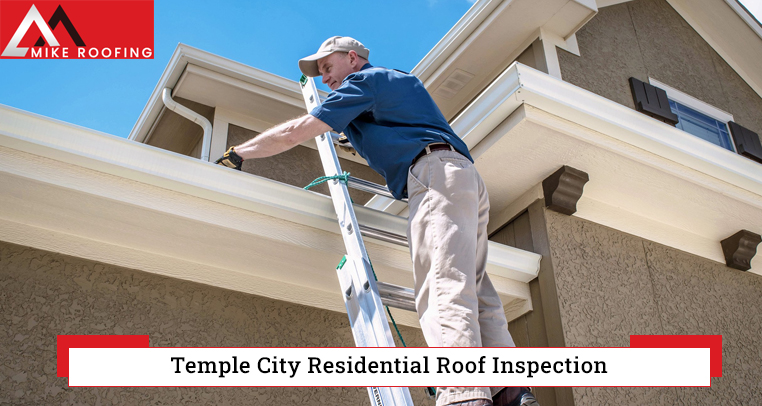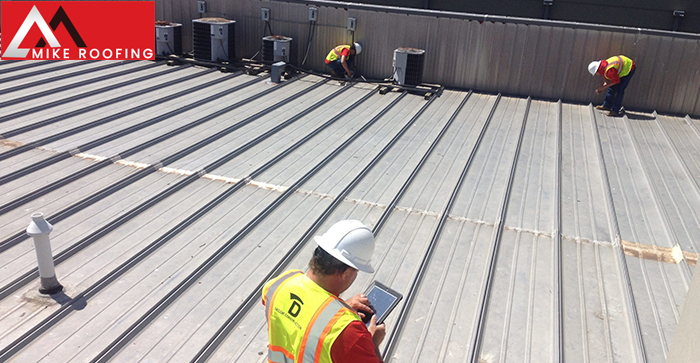Here are the different parts of the roof that will be checked by our experienced roofing contractors and the signs that you should look for

| Roof Component | Signs to Look For |
|---|---|
| Shingles | Cracked, curled, or missing shingles |
| Flashing | Damaged or deteriorated flashing around roof edges |
| Gutters | Clogged gutters, sagging or detached gutter sections |
| Chimney | Cracked mortar, loose bricks, or damaged chimney cap |
| Ventilation System | Poor airflow, excessive heat or moisture in the attic |
| Skylights | Leaks, cracked or damaged glass |
| Roof Valleys | Missing or damaged valley flashing |
| Eaves and Soffits | Rotting, peeling paint, or signs of water damage |
Thermal imaging is a non-destructive testing method used in roof inspections to detect temperature variations on the roof surface. It involves using infrared cameras to capture images that represent the heat distribution of the roof. It is commonly used in many Temple City Residential Roof Inspections. Get in touch now!!!

Thermal imaging can identify areas with moisture intrusion or water damage. Moisture appears as cool spots on the thermal images, allowing inspectors to pinpoint potential leaks or areas prone to water accumulation
Thermal imaging helps identify areas where heat is escaping from the roof, indicating potential insulation issues. This information can guide improvements to enhance energy efficiency and reduce heating and cooling costs.
Thermal imaging can detect overheating electrical components, such as faulty wiring or electrical connections on the roof. This helps prevent electrical hazards and ensures the safety of the building.
By visualizing temperature differences across the roof surface, thermal imaging can help determine the effectiveness of roof insulation. Inadequate insulation can lead to energy loss and increased heating or cooling demands.
The roof surface should be dry and free from obstructions, such as snow or debris, for accurate thermal imaging results.
An infrared camera is used to capture images of the roof surface. The camera detects infrared radiation emitted by objects and translates it into a visual representation of temperature variations.
The inspector scans the roof surface, capturing thermal images from various angles and distances. These images display a range of colors or temperature gradients, representing the heat distribution.
The captured thermal images are analyzed by a qualified professional who interprets the temperature patterns and identifies any anomalies, such as areas of moisture infiltration or heat loss.
A comprehensive report is prepared, detailing the findings of the thermal imaging inspection. This report helps guide further actions, such as repairs, insulation improvements, or addressing identified issues.
Core sampling is a method used in Temple City roof inspection to assess the condition of the roof layers beneath the surface. It involves taking small samples or cores from the roof to analyze the materials and identify potential issues.
Core sampling provides a direct and precise evaluation of the roof layers, allowing for an accurate assessment of their condition, including the quality of materials, presence of moisture, and potential damage.
Core samples can reveal hidden issues such as deteriorated insulation, water intrusion, structural damage, or signs of pest infestation. This helps identify problems that may not be visible from the surface.
Core samples enable analysis of the roofing materials, including their composition, thickness, and compatibility. This information is valuable for determining the overall integrity and performance of the roof system
By analyzing core samples, inspectors can determine the extent of damage or deterioration and develop appropriate repair or replacement plans tailored to the specific needs of the roof.
The roof area to be sampled is cleared of any debris or obstructions. Safety measures are taken, such as using appropriate personal protective equipment and ensuring a secure work environment.
Small samples or cores are taken from different areas of the roof, typically using specialized tools such as core drills. The cores are extracted carefully to avoid causing further damage to the roof.
The extracted core samples are analyzed in a laboratory or by a qualified professional. They are examined for factors such as moisture content, material composition, strength, and any signs of degradation or damage
The results of the core sample analysis are evaluated to assess the condition of the roof and identify any issues or potential risks. A comprehensive report is prepared, detailing the findings and recommendations for necessary repairs or maintenance.
It is recommended to have a professional residential roof inspection at least once every 1-2 years, depending on the age of the roof, environmental factors, and any previous issues. It is also advisable to schedule an inspection after severe weather events or if you suspect any damage or leaks.
The duration of a residential roof inspection depends on various factors such as the size of the roof, its complexity, and the extent of any existing issues. On average, a comprehensive inspection can take anywhere from 1 to a little more than 3 hours.
A residential roof inspection generally focuses on assessing the condition of the roof and identifying any issues. While we may provide recommendations for repairs or replacements, a separate estimate is typically required to determine the associated costs.